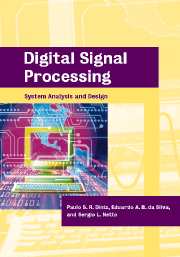Book contents
- Frontmatter
- Contents
- Preface
- Introduction
- 1 Discrete-time systems
- 2 The z and Fourier transforms
- 3 Discrete transforms
- 4 Digital filters
- 5 FIR filter approximations
- 6 IIR filter approximations
- 7 Finite-precision effects
- 8 Multirate systems
- 9 Filter banks and wavelets
- 10 Efficient FIR structures
- 11 Efficient IIR structures
- 12 Implementation of DSP systems
- References
- Index
10 - Efficient FIR structures
Published online by Cambridge University Press: 05 June 2012
- Frontmatter
- Contents
- Preface
- Introduction
- 1 Discrete-time systems
- 2 The z and Fourier transforms
- 3 Discrete transforms
- 4 Digital filters
- 5 FIR filter approximations
- 6 IIR filter approximations
- 7 Finite-precision effects
- 8 Multirate systems
- 9 Filter banks and wavelets
- 10 Efficient FIR structures
- 11 Efficient IIR structures
- 12 Implementation of DSP systems
- References
- Index
Summary
Introduction
In this chapter, alternative realizations to those introduced in Chapter 5 for FIR filters are discussed.
We first present the lattice realization, highlighting its application to the design of linear-phase perfect reconstruction filter banks. Then, the polyphase structure is revisited, discussing its application in parallel processing. We also present an FFT-based realization for implementing the FIR filtering operation in the frequency domain. Such a form can be very efficient in terms of computational complexity, and is particularly suitable for offline processing, although widely used in real-time implementations. Next, the so-called recursive running sum is described as a special recursive structure for a very particular FIR filter, which has applications in the design of FIR filters with low arithmetic complexity.
In the case of FIR filters, the main concern is to examine methods which aim to reduce the number of arithmetic operations. These methods lead to more economical realizations with reduced quantization effects. In this chapter, we also present the prefilter, the interpolation, and the frequency masking approaches for designing lowpass and highpass FIR filters with reduced arithmetic complexity. The frequency masking method can be seen as a generalization of the other two schemes, allowing the design of passbands with general widths. For bandpass and bandstop filters, the quadrature approach is also introduced.
Lattice form
Figure 10.1 depicts the block diagram of a nonrecursive lattice filter of order M, which is formed by concatenating basic blocks of the form shown in Figure 10.2.
Information
- Type
- Chapter
- Information
- Digital Signal ProcessingSystem Analysis and Design, pp. 453 - 490Publisher: Cambridge University PressPrint publication year: 2002
